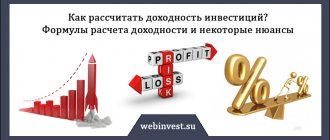In the last article, we came to the conclusion that the state, represented by the Pension Fund, will not be able to provide most people with a good pension. And NPFs, insurance companies and banks will not help much in the formation of a non-state pension. Therefore, you need to save for retirement yourself.
This article is about how you can save for your own retirement. The first thing you should do is make a financial plan. To do this, you need to answer three questions:
- When do I want to retire? Entitlement to a state pension begins at age 60 for men and age 55 for women. When to start receiving your personal pension, you are free to decide for yourself.
- How much do I want to earn in retirement? Let's say you want to receive 30,000 rubles. The pension calculator on the Pension Fund website shows that your state pension will be about 15,000. This means that you need to receive the remaining 15 thousand from your savings.
- How long do I want to receive my pension? The average life expectancy in Russia is 65-75 years. But some people live up to 80-85 or even 100 years. And the money shouldn't run out before you die. Therefore, it is advisable to plan your retirement so that the money does not run out until you are 90-100 years old.
Various experts often advise saving at least 10% of your income. Let's calculate what will happen if a person with a salary of 35,000 rubles saves 3,500 rubles a month for retirement for 30 years.
Let's imagine that the return on investment is equal to inflation. In this case, in 20 years, 1,260,000 rubles in today's money will have accumulated. If you spend 35,000 rubles a month after retirement, the money will run out within four years.
Saving 10% of your income is not enough to save for retirement. Profitability that covers inflation is also not enough.
Now let's try to calculate what if we save 20% of income and invest it at a rate of 6% above inflation. In this case, the money will run out only by the age of 97.
Where can I get a 6% return above inflation? The stock market can bring such returns. For example, since 2003, the return on the Russian stock market has been 16.5% with inflation of 9.1%, that is, the real return has been 7.4%. Of course, no one promises that the stock market will always generate such returns. But in the long term, it is stocks that bring the highest returns.
However, you should not invest all your money in stocks. A well-designed portfolio should include a variety of asset classes.
Stock
A share is a share in a company, and over the long term they are the most profitable instrument. On the other hand, this is the riskiest asset, since shares can not only rise significantly, but also fall significantly; income on them is not guaranteed. In addition to income from price growth, shares can generate income in the form of dividends.
To invest in individual stocks, you need to learn how to select promising companies. To do this, you need to study fundamental analysis (How to choose stocks for investment), regularly read company reports and analyze their valuation and prospects. This will take a lot of time, and there is no guarantee that selecting individual stocks will bring you good returns.
Bonds
A bond is a debt security for which the issuer pays interest to the owner of the bond, and at the end of the term pays the face value (body) of the bond.
Bonds provide a small (at inflation rate or slightly above) fixed income (coupon). Typically, the longer a bond's maturity, the higher its yield.
The most reliable bonds are government bonds (OFZ). There are also municipal and corporate ones. They bring higher returns than government-owned ones, but carry greater risk. The main risk for bonds is credit risk, that the issuer will not be able to service the debt and will stop paying income on its bonds. Therefore, you need to invest either only in OFZs, or learn how to choose reliable bonds (How to choose bonds).
Gold
Gold is a commodity whose price depends on supply and demand on the world market. It does not pay interest or dividends, and is subject to commodity cycles. However, gold in people's memory still remains a protective asset, to which everyone runs when they panic. Therefore, during severe crises, the price of gold rises.
Mutual funds
A mutual fund is a mutual investment fund that pools the investments of investors and invests them in certain financial instruments. Mutual funds can invest in stocks, bonds, real estate, funds, precious metals and other instruments. The profitability of the fund depends on the selected assets and the talent of the fund manager. A separate category of mutual funds are index ones. Their main task is to repeat the dynamics of the market index.
Mutual funds have a low entry threshold from 5,000 to 15,000 rubles. When investing in mutual funds, there is no need to choose stocks or bonds yourself; the manager does this. But there is no guarantee that the fund manager will be talented enough for the fund to generate good returns. Many mutual funds underperform an index over the long term, so index mutual funds are the best choice.
The big disadvantage of mutual funds is their high commissions. For fund management, the management company can charge between 1.5% and 3% per year, which is bad for their returns. Plus, when buying and selling, a one-time commission from 0% to 1.5% is charged. The liquidity of mutual funds is average - several days pass from the moment the fund shares are sold until the money arrives.
Unfortunately, in recent years the reputation of some mutual funds has been tarnished: some funds unilaterally increased their commissions, others simply reclassified, for example, from a stock fund to a fund of funds.
Exchange Traded Funds ETFs
ETFs are exchange-traded funds that are traded on an exchange. Most of the world's ETFs are index-based, that is, they are focused on repeating the dynamics of a particular index of stocks, bonds, commodities, real estate, etc.
At the moment, only 12 ETFs of the manager ]Finex[/anchor], registered in Ireland, are traded on the Moscow Exchange.
ETFs are a more liquid instrument than mutual funds; money from their sale can be received the very next day.
The advantage of Russian ETFs is also lower commissions compared to mutual funds - no more than 0.9% for management plus a few hundredths of a percent per transaction is paid to the broker. An ETF cannot simply increase its fees or reclassify as a different fund.
The disadvantage of ETFs from Finex is that they essentially have no alternative within Russia and a very small selection of funds. Also, Phoenix ETFs have higher commissions compared to their foreign counterparts, where fund commissions are usually no more than 0.2%. For some, it will be a minus that Finex ETFs, unlike foreign funds, do not pay dividends.
Individual investment account
A good option would be to invest in an individual investment account. An IRA is a special type of account that can be used to purchase securities, and which entitles you to a tax deduction or preferential taxation of investment income. It can be opened with a broker or management company.
There are two types of tax deductions: on contributions and on income. A deduction for contributions is provided in the form of 13% of the amount contributed to the IIS for the year, but not more than 400,000 rubles (that is, no more than 52,000 rubles can be returned per year). The second type of income deduction - this type of deduction exempts the investor from paying tax on income received on IIS. Unlike the first type, in this case the amount of deduction is not limited. (Everything you need to know about IIS)
Using these tools, you can develop an investment strategy and create a long-term investment portfolio to save for retirement. When constructing a portfolio, you need to consider risk tolerance, investment period, fees, taxes and other factors. A well-designed portfolio will provide a return of several percent per annum above inflation and reduce risks.
How much money do you need to be happy?
What kind of pension would you like to have when you get old?
20-30 thousand. Maybe 50. Why waste time on trifles. The option of 100-150 thousand would suit most.
How much do you earn now?
If you have a small salary, then be realistic. It is unlikely that you will be able to save for retirement several times your average monthly income.
You can proceed from the rule: how much you earn now, that’s what your pension will be. Naturally, if you take the right measures right now.
A person receiving a salary of 30 thousand per month is able to save for a similar pension in the future. Just like the lucky person who has an income of 500 thousand per month. They will have the same principle.
Can you expect more?
Yes and no.
It all depends on several factors.
Main success factors:
- time;
- investment amount;
- return on investment (don’t forget about inflation) or where to invest money.
The principle is simple: the more, the better.
A savings period of 20 years will yield much more than a five-year period.
Which is more profitable? Should I save 2 thousand or 5 thousand monthly? (a rhetorical question).
Invest money at 2% per annum or at 10?
The good news is that all of these factors are interchangeable. If you can’t save a lot (for example, with a small salary), then you need to increase the savings time.
Time is running out. Retirement is just around the corner. And there are no 20-30 years left. This means you need to increase the amount of money you save for the future.
Tip 1. Non-state pension funds
As we said above, 6 percent of deductions from wages are mandatory contributions to the funded part of the pension. Ideally, to start saving a pension, a citizen should choose any non-state pension fund that will collect contributions by the ruble, use them at their discretion so that the money grows in value, and, as their clients retire, pay a monthly amount, the amount which is determined by the amount of savings.
In reality, things are a little different. Half of citizens do not know where their pension savings are, and 25% do not even understand what it is. In the absence of the will of the future pensioner, his savings automatically go to the Pension Fund of the Russian Federation, or more precisely, to his management company - Vnesheconombank.
The payer of pension savings has the right to transfer his savings to any non-state pension fund.
Simply put, a non-state pension fund is a state-licensed investment company that has the right to collect citizens’ deposits. Savings are invested in various sectors of the economy and bring income to both people, the state, and the investment company itself. This is a worldwide and very good practice. For example, no one will stop the Bavarian non-state pension fund from investing the savings of its clients both in the BMW concern and in the rapidly developing Chinese industry. There is no place for patriotism in matters of profit. The main thing is that the money is multiplied legally.
But the activities of Russian pension investment companies are very limited. They have the right to invest their clients’ savings only where the state directs them. And the state points to domestic sectors of the economy that are going through far from the best times. The result of limiting the freedom of action of pension funds was that citizens' savings were frozen. That is, instead of generating income, the collected money was simply devalued.
Conclusion: Transferring pension savings to non-state pension funds could be profitable if the funds themselves had freedom in choosing investment objects. At the moment, all pension savings made by Russians have depreciated even below the officially stated inflation rate, and their indexation is frozen until 2021. Indexing forecasts are disappointing.
You will not be able to get rid of these types of payments and start saving them in any other way. Either the Pension Fund of the Russian Federation, or a non-state pension fund - there are no other options. And, as practice shows, both of these options are no different from each other.
Step-by-step plan for saving for retirement
You will be disappointed, but perhaps I will not reveal anything new to you.
Algorithm of actions:
- They set aside part of what they earned (10, 20, 30% of income).
- Invested in income-generating instruments.
- We reinvest all profits received.
- The next month it’s all over again.
And so month after month. Year after year. Decade after decade. Like a trained monkey. Until you achieve results.
True, there are no main conditions here.
- How long will it take?
- How much should you save monthly?
- What kind of profitability can you expect?
Only by knowing the answers to these questions can you accurately plan a financial plan for the formation of your future pension.
About individual pension capital in the Russian Federation
The head of the Central Bank of the Russian Federation, who became a regulator at the federal level, recently spoke about the latest reforms in pension legislation. In particular, Nabiullina warned that the individual pension capital system will become a priority area of work for the Central Bank, which fully supports this innovation.
What is individual pension capital? These are savings for the future - for old age, and everyone must take care of them on their own, but the state will have a management function in relation to savings, as it previously managed the pension contributions of citizens of the Russian Federation.
The head of the federal regulator assures that pension savings are very important for the country, since they are a source of long-term money. IPK, according to Nabiullina, appears to be a stable, reliable and sustainable business model for Russia.
If we take away the pompous speech, we can simply say that IPC is the concern of Russians about their old age against the backdrop of the lack of hope for any government support. So to speak, you have saved up money, you will live, no, it’s your problem.
No one will be exempt from paying contributions. Although the capital is individual, the Russians themselves must transfer it.
Investment options
Let's start with the most important thing - profitable instruments.
We need investments that allow:
- Protect money from inflation.
- Receive additional income.
For myself, I chose 2 main directions - stocks and bonds.
Anything else is slag, not very suitable.
We forget about high-risk and dubious investments: PAMM accounts, HYIPs, pyramids, cryptocurrencies.
We can't risk our future. And in the first place is accumulation, with protection from possible financial losses.
There is also gold and deposits. But... they don't really meet our requirements. Yes. They protect money from inflation. But nothing more. At best, they will give about 1-2% increase. Above inflation. The key word is “at best.”
Tip 3. Investments in real estate
This is the most pharisaical of all advice. Not because it is bad, but because it sounds mocking towards ordinary Russians. Those who have the opportunity to invest in real estate are not at all interested in the issue of saving for old age.
Advice! If, nevertheless, you have saved enough to purchase a couple of apartments for their subsequent rental, remember - this is a very dubious foundation for old age. Experience suggests that real estate for older people does not benefit them at all in old age. Grandchildren and great-grandchildren benefit when loving grandparents give them an apartment for their wedding.
How much can you earn from this?
The stock market on average grows by 4-6% above inflation. But only for a long term - 10-20 years.
Bonds give about 2%.
This is historical data. Tested over long periods of time. Since the beginning of the 20th century. In some countries, even since the mid-19th century.
Why don't we take inflation into account?
We plan for retirement based on today's value of money. No one knows what inflation will be like in 5, 10, 20 years. Profitability, cleared of inflation, shows the real financial result.
Look.
In one year the return will be +10%. In another - +25% per annum. Which result is better?
And it is unknown. Perhaps in the first year inflation in the country was 5%. And in the second 35%.
Then 10% profit is better than 25%. Real yield +5% versus - ( minus) 15% .
A classic way to save for a comfortable old age
While there is no normal system of pension savings, Russians are saving for old age using other methods. The classic one is bank deposits. Deposits are good for everyone: they are insured by the state, are inherited, and can be used at any time. Although the last advantage is rather a disadvantage: not everyone can resist the temptation and spend money. At the same time, deposits in the last two or three years have ceased to bring real income.
Bank
Where can I buy?
ETFs are traded on the Moscow Exchange.
Go to a broker and open a brokerage account (no more difficult than opening a deposit in a bank). Many even allow you to open accounts remotely (online).
I recommend: TOP 7 best brokers for beginners
The purchasing process itself is no more complicated than ordering in an online store. Download the broker's mobile application. And you can buy securities every month.
What to buy?
Stock ETFs are more profitable. Bonds are more reliable.
During a crisis, shares can decline by tens of percent. But in the long term, they are the ones who bring the most profit.
But you shouldn’t give up bonds either.
Some balance is needed. What proportions will the portfolio consist of?
The simplest is 50/50, 70/30.
The main principle of portfolio formation: the more time you have in stock, the larger proportion of your money you need to allocate to stocks.
Tip 4. Buy currency
To this advice I would like to give anti-advice - do not buy currency. Saving for old age should be safe in the long term. Currency savings do not provide the required security for the following reasons:
- The exchange rate is set by the state depending on its needs and does not correspond to the real exchange rate.
- It is always possible to prohibit transactions with currency for individuals. Then your foreign currency savings will be withdrawn at the established artificial rate. Most likely 1:1.
- Any currency is not eternal, nor is the country of its origin. With the collapse of the EU, the euro will die, with problems in the US, the dollar will die, with the rise of China, the yuan will strengthen, and with the development of some super technology, the Bulgarian lev will become the world currency. It is impossible to foresee risks.
How to calculate potential profitability?
For example, the proportion is 50/50. Expected annual return on shares is 5%. Bonds - 2%.
Total 3.5% per annum.
Stocks/Bonds in proportion - 70/30.
We calculate: (5% x 0.7) + (2% x 0.3) = 3.5 + 0.6 = 4.1% per annum.
Let's round up to 4%.
By the way, most retirement and investment strategies are based on the 4% rule. In any situation, even the most unfavorable, you can count on the desired profitability. I'll repeat it again. Only for long periods.
Perhaps the estimated profitability will seem too meager to you. But it is what it is. Of course, there is always the possibility of making a much larger average annual profit. But I adhere to a cautiously pessimistic outcome of events. Excessive optimism (counting on high returns), in the event of an unfortunate combination of events, will not allow me to save for retirement with a guarantee . And as they say: “it’s better to be too safe than to be too late.” )))
Real estate
Another way to supplement your retirement is by investing in real estate. In our country, this asset has always been considered reliable - the apartment will not disappear anywhere and will not depreciate, like money as a result of devaluation. The apartment can be rented out and receive an increase in pension. And the price of real estate and rent is growing in the long term.
However, this method is also not without its drawbacks:
- high entry threshold - to buy an apartment you first need to save several million;
- the option of taking out a mortgage and renting it out will not work - loan payments will be higher than rental payments;
- you need to choose the right apartment (an apartment in a remote area without transport and infrastructure cannot be rented out to anyone);
- you need to look for tenants and be able to choose solvent and adequate ones who will not destroy your precious apartment;
- Recently, the price for rental property has been decreasing or not increasing;
- the average rental interest rate is 4-5% per annum;
- real estate may stand idle without income;
- it is difficult to sell an apartment quickly - low liquidity;
- the apartment periodically requires repairs, as over time they wear out and become outdated;
- tenants can cause damage - break something or even start a fire, so it is advisable to insure the apartment;
- property taxes are rising.
In general, real estate is a rather troublesome investment option that requires significant capital. In addition, it has its own risks, so it is not advisable to save for your retirement only in real estate, but it is acceptable if it takes up some part of your portfolio.
Is retirement possible?
We've sorted out the expected minimum return. 4% per year above inflation.
Next, we decide on the goal. That is, with capital that allows us to live with dignity. Or at least satisfy basic needs.
There may be 2 options here. Simple and... immortal.
I don't really like the first option. Its meaning is as follows.
Let's say you plan to retire at age 60. And here is the most interesting thing... determine how many years you plan to live after this. 5-10-15 years, maybe 30-40 (optimists).
After retirement, divide the capital by the number of expected years of survival. And every year you extract money for living from the formed capital.
With our conditional required pension of 30 thousand, the annual needs (for 12 months) will be 360 thousand per year. This is why we dance.
- for 5 years of retirement life you need to save 1.8 million;
- for 10 years you need to save 3.6 million;
- 15 years - 5.4 million rubles;
- 20 years - 7.2;
- and so on.
The main problem is that suddenly the money runs out. And you haven't planned to die yet. Perhaps in a few decades, technology will significantly increase average life expectancy.
The second trouble: your heirs (children, grandchildren, great-grandchildren) will have nothing left after you.
The second option involves the possibility of “eternal” life on pension. No capital reduction.
Only the profit received is withdrawn for living. Above inflation.
In our case, you can safely spend 4% of your capital every year. And live on this interest.
And here lies the main difficulty. You will need to save up a little more than in the first case.
For an eternal pension of 30 thousand per month, you need at least 9 million rubles. If you want 50,000, save 15 million.
But you can then fearlessly spend a certain amount of money. Without fear that it will suddenly end.
And you can pass on an eternal pension to your descendants. Which they will most likely completely lose in a couple of years.)))
Tip 2. Bank deposits
Those who lived in the USSR remember how Soviet citizens saved money in savings books. Now many families, like rarities of a bygone era, keep gray books from Sberbank of the USSR. The amounts accumulated in savings banks have died for a long time, and no one will return them.
Having decided to save money for old age in a bank, it is always worth remembering that a bank is not an eternal phenomenon. The bank may go bankrupt, the bank's license may be revoked, or inflation will eat up your savings.
If, nevertheless, you have opted for a bank deposit, then you should listen to a few tips.
Important!
- Try to diversify your investments. Spread them out over several banks.
- Do not rely on bank ratings. The rating is not an indicator of the bank's success. Rating is the bank’s participation in rating programs, that is, the openness of its operations to rating experts. Therefore, the first places in the ratings of Russian banks are occupied by banks with state capital. A huge number of very successful banks refuse to participate in the ratings. At the same time, both banks and their clients prosper.
- Follow banking news closely. At the slightest concern, close your account. Remember that the chance to return the money is higher for those who came to collect it first.
How long does it take to save?
Once you have decided on the pension amount necessary for life, we calculate the time frame for achieving it.
Is it even possible to achieve a goal during life?
Here you need to play with numbers: term (number of years) and monthly deposited amount.
For these purposes, you can use an investment calculator.
- We enter the expected return - let it be 4%.
- Duration - in years.
- And the amount of replenishments (annualized).
If you are not satisfied with the option, you need to:
- increase the period of savings;
- or increase the amount of money you save.
In the short term, the size of the replenishment will have the greatest impact. If you have 5-10 years left before your expected retirement, then, if possible, you need to maximize contributions to your future pension.
If retirement is still far away (20-30 years), then you are in luck. You can get away with small sums. And accumulate some capital.
Ideal financial strategy
When starting to get acquainted with the investment market and its opportunities, many clients ask financial advisors whether there is an ideal plan for increasing capital? In my opinion, there is not and cannot be a single scenario for achieving financial goals. This is due to several factors.
Firstly, each owner of capital has unique needs: some of our fellow citizens want to accumulate as much money as possible for their mature years and pass on an inheritance to their children and grandchildren. Other Russians strive, first of all, to significantly improve their current standard of living, for example, to go on vacation to Europe several times a year, purchase comfortable housing in the center of the capital and become owners of high-status cars. It is irrational to use the same investment strategies to implement different financial plans.
Secondly, the situation on the stock market is constantly changing. Securities of those enterprises that allowed you to increase capital several years ago may be completely ineffective today. The capital market is subject to constant dynamics; only experienced specialists can track and, even more so, predict its development.
Future pension calculations
I put in the table below, approximate results for different initial data.
How many years will it take you to save for a pension equal to your current salary? By saving a certain percentage (from 5 to 50%) of your income. With a yield of 4% per year. Above inflation.
To be honest, the results are not very impressive. Especially the top half of the table. Saving money for half a century? Yes, people don’t live that long. Something needs to be done.
In fact, you can slightly reduce the accumulation period.
You save 20% of your income every month for the rest of your life. So you are used to living on the remaining 80%. And accordingly, the minimum required pension amount may no longer be 100%, but 80% of income. And you will need not 45 years, but “only” 40. (((
By allocating 30% of your salary to form a pension, you need to save up 70% of your income (it will take 30 years instead of 36). And so on.
You can simply save money, counting on a certain increase in the form of your own monthly accumulated pension. Let this not be the expected average monthly salary. A little less.
Made the calculations. How much can you earn (accumulate, increase) over different periods of time with different amounts of funds allocated from income (blue columns). And what will be the average monthly “personal” pension (green columns).
Pension fund holes
The catastrophe in the Russian pension fund is obvious. This is very easy to understand if you spend a little money.
So, for 2021, according to statistics:
- The number of pensioners is 45 million people (including those receiving a survivor's pension, people disabled from birth, etc.)
- The number of officially employed people is 72 million.
That is, for every pensioner there are 1.6 working payers of contributions to the pension fund. The amount of their payments is monthly 10% of the salary in the Pension Fund, 6% to the solidarity fund and 6% to the funded part of the pension.
22% with an average salary of 20,000 rubles is approximately 60,000 rubles per year. We take very average numbers. That is, during the year, all Russian workers annually contribute 72 million × 60 thousand = 1 trillion rubles to the “mutual aid fund”.
We divide a trillion by the number of pensioners and we find that each Russian pensioner can count on only 22,200 rubles per year. Of course, other government funds are added to this figure, but the general trend is clear - there is nowhere to take pensions from, and those who are now paying insurance pension contributions are not actually creating pension capital for themselves, but are only slightly patching up existing holes in the pension fund.
What investment opportunities does every citizen have?
As you know, pensions in our country are small. You can live on them, but without any frills, much less the opportunity to travel. Plus, the retirement age has been raised. The average life expectancy is increasing, so perhaps it will increase even more in the future. At the same time, the size of the pension does not increase because a person reaches it later, but health deteriorates in old age.
Using your savings, you can retire early, but to do this, you should think about its formation in your youth. The ideal option for every person is to take care of their future independently now. The sooner you start saving, the more opportunities you will have. Of course, if there are literally a couple of years left until retirement, then there are much fewer opportunities.
There is an opinion that before the age of 30 you need to invest in yourself in order to achieve maximum growth on the career ladder. This is partly true. But here the question is rather that few people think about retirement before the age of 30. Most people at this age start families and buy apartments. They are of little interest in long-term savings, but in vain. Each extra year of investment gives a significant increase in the result obtained over decades.
Therefore, regardless of age, you should always put at least a couple of thousand rubles from your salary into an investment piggy bank (we’ll talk about it later).
It is important to remember that everyone has the opportunity to retire early and still provide themselves with a solid income.
Enforcement for state employees
The latest change in the pension savings system does not inspire much confidence, experts interviewed by Fintolk agree: the newly proposed system may also suffer the same fate as the funded part of pensions.
The state pension plan is suitable for those who are not ready and have no desire to join the ranks of investors and torment themselves with a difficult choice of financial instruments, says Vyacheslav Maksimenko, head of partnership programs at the investment and educational platform Lineyka . In this case, the plan is a good alternative to a product such as long-term life insurance - because the insurance is not guaranteed by the Deposit Insurance Agency.
“At the same time, the future pensioner, in order to benefit from the state pension plan, will still be forced to make the right choice of pension fund - after all, investment income and the size of the “increase” to the state insurance pension depend on the professionalism of the manager. And since you already have to understand pension funds, the future pensioner will consider it more appropriate to understand the intricacies of the operation of the rest of the financial market.”
Having understood at least a little about the intricacies of the stock market, future retirees will most likely pay attention to individual investment accounts, the expert is sure. There you have the opportunity to either receive 13% of the deposited amount, or be exempt from income tax on the amount earned from trading securities. “IIS are not insured by the state, but, quite likely, in the foreseeable future this issue will be resolved in favor of the investor,” says Vyacheslav Maksimenko. “This is not counting the fact that an increase in the size of tax benefits is also being discussed.”
Pavel Sigal, first vice president of Opora Russia:
Since the benefits offered to participants in the state pension plan are either not really benefits, or they still exist, there is no incentive to save for retirement using this product.
The new pension system looks so neutral for citizens in terms of providing income, guarantees and other privileges that if it had not been discussed by the media, the majority would probably never have known about it, and even if they did know, they would hardly take advantage of it. voluntarily,” says Anton Bykov, chief analyst at the Center for Analytics and Financial Technologies . Therefore, the pension plan will probably be used only among civil servants, officials and employees of state-owned companies, as a voluntary-compulsory part of the pension provision.
Accordingly, the rest literally have no choice but to save on their own - if there is no desire to meet old age with the current size of the pension.
Anton Bykov, chief analyst at the Center for Analytics and Financial Technologies:
Now citizens can hardly survive on a state pension, and in the future, given current socio-economic trends, this will be completely impossible. Therefore, if a citizen does not foresee the victory of socialism by the time of his retirement, it is absolutely worth taking the process of forming pensions into his own hands, says Anton Bykov. “And the state system is clearly not a panacea here, because it does not offer absolutely any innovations in comparison with existing financial instruments.
What is profitable to invest in to beat inflation?
Simply by putting money under the mattress (or even by taking it to the bank), we will lose due to inflation. Therefore, in order for us not to go down the drain, money must bring in money.
What assets can become the basis for pension savings? Today the rating looks like this:
- Government bonds. A good choice for inflation protection because these securities provide a fixed rate adjusted for inflation. According to the generally accepted standard, such bonds should constitute approximately 70-80% of the entire portfolio of securities of a cautious investor.
- Corporate bonds. Companies also issue bonds with high, medium or low yields. Potentially they provide a greater “exhaust” than state-owned ones, but are associated with the risk of default - the company may go bankrupt without fulfilling its payment obligations. It is better to give preference to medium-risk bonds with a short maturity.
- Dividend shares. Stocks are not considered low-risk investments, but in general, dividend-paying assets are good for long-term investments. It is dangerous for a person without experience to speculate on prices, but dividends drop steadily and can be reinvested in other areas.
- Preference shares. Preferred stock is more like a bond, but it gives you a stake in the company and limited voting rights. It is generally safer than regular dividend stocks because preferred stockholders get paid after bondholders but before common shareholders.
- Shares in ETFs and mutual funds. Shares in mutual funds or ETFs are another interesting avenue for investing. The level of risk is higher than that of bonds, but the potential return is also higher.
Real and nominal yield
By determining future profitability and the final capital that is obtained over time, we will have the so-called dirty result, without taking into account inflation. And this is not exactly the result we are hoping for. After all, the indicator of wealth is not the amount of money, but how many goods and services we can buy with it at the moment.
Agree that 100 thousand rubles now and 10 years ago are two big differences. Previously, this money could buy much more than it can now.
Therefore, it will calculate the real rather than the nominal return on investment, which will give a more plausible result.
How to build your retirement portfolio
A prerequisite is competent risk management.
This term means analyzing potential losses and adapting your trading strategies to the minimum acceptable level of risk. For example, one of the most successful investors, Warren Buffett is known for laying out the two most important rules of investing:
- Rule #1: Don't lose money.
- Rule #2: Never forget Rule #1.
But these are lyrics. Here are real ways to manage investment portfolio risk:
- Follow the trend. A trend is our friend until it ends.
- Keep track of your balance. A long-term investor should not monitor the market and periodically change the ratio of his assets in the direction of the highest return. The briefcase will do this work for him.
- Adjust positions. If your life goals have changed, then it's time to review your portfolio. Everything else should not matter to you.
- Diversify your portfolio. The idea of diversifying investments is to buy asset classes that are not related to each other. This means that if one goes down, the others will pick up the slack.
What ratio is ideal for a long-term investor?
A generally accepted ratio is 70% bonds, 20% stocks and 10% mutual funds or ETFs. But this is not canon.
The strategy can always be adjusted to suit your age, level of trading activity and other parameters. An example of a portfolio can be seen here, and here are instructions on how to create it.











